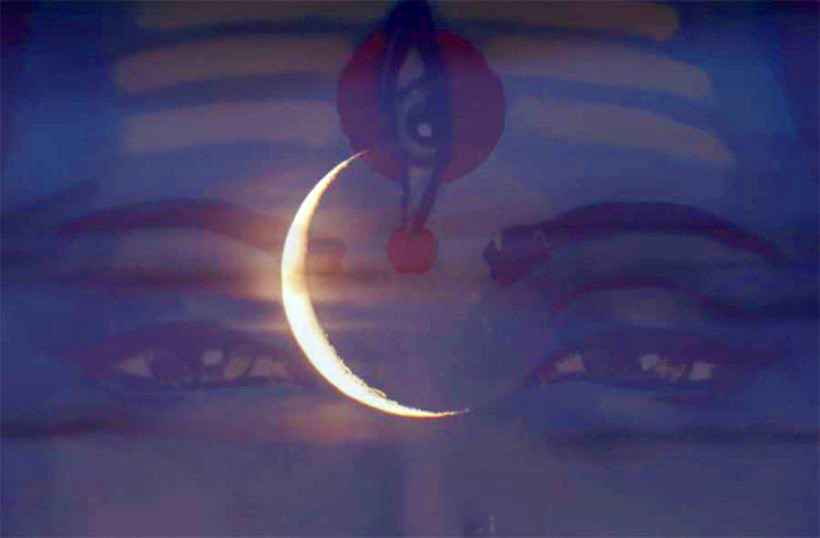
by Somya Devi | Feb 28, 2019 | Astrology, Conjunctions, Holy Days, Planets Changing Signs, Retrograde
The Moon wanes in sidereal Aquarius on the dark night of March 5th, approaching the exact Sun-Moon alignment for a New Moon at 8:04 am on Wednesday, March 6th, beginning a new lunar cycle. Leading up to this will be Maha Shivaratri, “the great night of Lord Shiva,” on March 4th. This is an auspicious night for prayer and penance, and the benefits of sadhana are multiplied by the Moon’s position and the collective vibration.
Maha Shivaratri
Monday night, March 4th, the night prior to the Dark Moon night, is the fourteenth waning phase of the lunar cycle. During this month this night is celebrated as Maha Shivaratri. This is perhaps the most auspicious night of the year for doing sadhana (spiritual practice). It is traditional on this night to stay up all night fasting, chanting, praying, and meditating. This holiday honors Lord Shiva, the great ascetic, and we can recall two stories of great sacrifices that he made protect the entire creation.
One of these is the story of the churning of the milk ocean, which the gods and demons were doing in order to release the nectar of immortality. Before the nectar came up, however, a poison came up first. (This is similar to when we do spiritual practice and begin our path of self-inquiry, and negative tendencies often come to light first, which can be a painful experience. Similarly, during a physical fast or cleanse, toxins can be shaken loose and released first, causing a healing crisis before we continue healing into a freer, happier state of being.) When the poison came up from the milk ocean, Lord Shiva consumed it so that it would not engulf humanity, as a great and noble sacrifice. His wife, Parvati, however, held his throat so that he could not ingest it, thus saving him from being harmed by the poison.
Maha Shivaratri also commemorates the wedding of Shiva and Parvati, which also stemmed from great sacrifice made for the benefit of all humanity. It was said that after his first wife, Sati, perished, Shiva was fully devoted only to his sadhana, meditating for aeons in isolation and renouncing the world. Then the demon Tarakasura began running amock on earth, threatening all of humanity. Brahma foretold that only Shiva’s child could defeat Tarakasura, so the gods devised a plan for Sati to reincarnate as Parvati, and win over her Lord to marriage once again. He was not easily swayed, however, and it was only after Parvati became an ascetic and underwent great penance that he agreed to marry. They eventually produced their son Kartikkeya, who went on to slay the demon.
Thus, this holiday is celebrated through the penance of fasting, forgoing food, water, and sleep, for one night, and simultaneously celebrating the union of Lord Shiva and Parvati, or the masculine and feminine energies of creation, that allows this dance of life to continue. It is an apt time to feel the forces of Aquarius upon us, which compel us to consider our role in society, and in the universe, and what personal sacrifices we can make for the greater good. Even if you’re not able to stay up the whole night, any amount of devotional practice, serviceful sacrifice, or chanting of Om Namah Shivaya on this night can have beneficial affects that are magnified greater than on any other night.
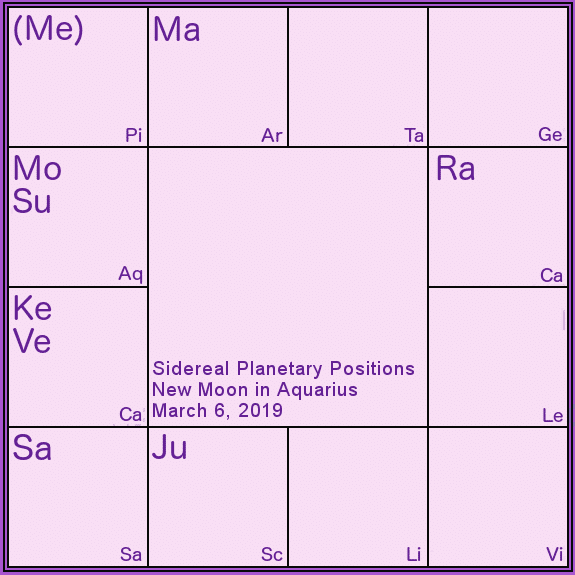
Aquarius Moon Cycle
The Sun and Moon meet in sidereal Aquarius to begin this lunar cycle. Aquarius is known as Kumbha in Sanskrit, a word for “pitcher” or “vessel.” According to the Vedic texts, the sign Kumbha can be imagined as a man holding a pot, with deep-brown skin, standing in the water. We can see this Aquarian imagery in the sadhus of India (and its biggest ritual pilgrimage day, the Kumbha Mela), who make their lives an offering of service to society through their prayers and Saturnian austerities, while renouncing the individual self. In the Aquarius cycle, we think about how we can serve the whole.
Saturn both rules Aquarius and is aspecting the Sun and Moon here (from sidereal Sagittarius) at the time of this New Moon. Saturn brings to us awareness of the long term and the bigger picture, and through this masculine or active sign, compels us to make commitments and offerings to something greater than ourselves and our momentary happiness. This is a great month to consider a new way that you may be of service to your community or to society.
Purva Bhadrapada
The New Moon cycle begins with the Sun and Moon in the Vedic nakshatra called Purva Bhadrapada, the former “lucky footed one.” This nakshatra bridges Aquarius and Pisces and is often represented by a funeral cot, symbolizing the transition from life into death, or ultimate liberation. It is ruled by Aja Epakada, the one-footed goat who is often associated with the image of Lord Shiva as Nataraj dancing on one foot, a fitting image for Maha Shivaratri.
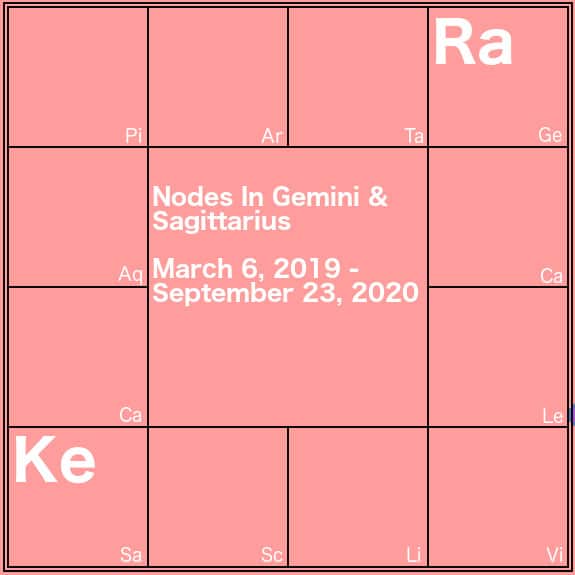 Nodes Are Changing Signs!
Nodes Are Changing Signs!
With a mean node calculation, Rahu and Ketu will transit into Gemini-Sagittarius on March 6th. (Under a true node calculation, they will not change signs until March 23rd; See Technicalities: Mean vs. True Node section below if you want a little more info about nodal calculations.) Regardless of the calculation used, March is a month of transition for the nodal energy. With the nodes in Cancer-Capricorn for the last year-and-a-half, we collectively felt a dichotomy between listening to the heart and following our emotions, against doing what is practical and responsible in an earthly way. It was a chance to balance these two things as well, learning to create a harmony between the practical and the emotional.
Throughout the coming transit of Rahu and Ketu through Gemini and Sagittarius, we will be feeling a polarization between curiosity, fact-finding and learning in an intellectual way, versus taking actions based on our principles and beliefs. Sometimes the intellectual mind does not agree with our fiery passions. This transit will be a time to learn to balance the two. With opinionated Sagittarius on one side, and communicative yet flexible Gemini on the other side, we may learn new ways to communicate and interact with those who oppose us in ideas, stepping into another’s shoes while still maintaining and honoring our personal beliefs and philosophy.
For each natal rising sign, this coming transit will affect a particular axis of learning in your life. You will be more able to see and work with some of your blind spots in these areas throughout the coming year-and-a-half long nodal transit. These things will especially surface around the bi-annual pairs of eclipses (coming this year in July and December).
Mercury Retrograde
Mercury stations and begins apparent retrograde motion on March 5th, the day before the New Moon. He is also currently debilitated in sidereal Pisces, so this time period could have us a bit mixed up around some details, and possibly challenged with communication and accuracy. He’ll retrograde back into Aquarius on March 14th, before returning to direct motion on the 28th.
Jupiter Gandanta
Also during the first half of this lunar cycle, Jupiter will enter the last 48 minutes of sidereal Scorpio (one muhurta), on March 15th. This region of the sky, called gandanta or a “knot,” is considered one of the most difficult places in the zodiac. It spans for one muhurta before and after the 0° point between sidereal Scorpio and Sagittarius, as well as those regions on the cusp of Cancer-Leo and Pisces-Aries (however, this gandanta location is often considered the most difficult. (Some astrologers may consider it spanning up to one or even two or three degrees to either side of the cusps.)
Normally, a planet transits through this zone rather quickly. Jupiter is currently slowing down, however, and will come to a stationary halt at 0°14’ of sidereal Sagittarius on April 10th, before beginning retrograde motion and passing back into Scorpio. He will threrefore be traveling the gandanta zone all the way from March 15th until May 6th (or longer if the zone is interpreted as wider).
Though Jupiter will be dipping into his own sign from March 15th through April 22nd, the fact that he will remain in gandanta at this time will not bring the added strength that we would expect from a sva graha. Those who are ruled by Jupiter may feel a bit “stuck” in various ways throughout this transit. It is important to be patient and keep up with sadhana during this time. Additionally, he will be joined by both Saturn and Ketu during his time in Sagittarius, both of which can be challenging companions.
Technicalities: Mean vs. True Node
Rahu and Ketu have been transiting through the Cancer-Capricorn axis for nearly 18 months, and are getting ready to make their transition into the Gemini-Sagittarius axis, for the next 18. The date of this transition will vary whether you are using the “mean node” calculation or the “true node” calculation. To simplify this as much as possible, we must realize that the nodes do not have planetary bodies that can be observed as the other grahas can be. (The grahas are “the forces that grab us,” including the Sun, Moon, Mars, Mercury, Jupiter, Venus, Saturn, Rahu and Ketu.)
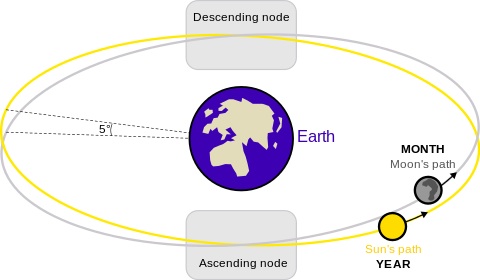 The nodes, astronomically are the places where the Sun’s and Moon’s paths intersect. The ecliptic is the apparent paths that the Sun travels “around” the Earth. The Moon’s orbits is not completely flat or parallel with the Sun’s, but slightly inclined, so that it passes this line and is sometimes to the north of it, sometimes to the south. We can measure astronomically and by observation when these crossings happen. To get the mean node, we take an average distance between these two points based on how many days it takes the Moon to get from one to the other. The true node is calculated using a method that also accounts for the slight wobble of the earth and the Moon’s orbit around it.
The nodes, astronomically are the places where the Sun’s and Moon’s paths intersect. The ecliptic is the apparent paths that the Sun travels “around” the Earth. The Moon’s orbits is not completely flat or parallel with the Sun’s, but slightly inclined, so that it passes this line and is sometimes to the north of it, sometimes to the south. We can measure astronomically and by observation when these crossings happen. To get the mean node, we take an average distance between these two points based on how many days it takes the Moon to get from one to the other. The true node is calculated using a method that also accounts for the slight wobble of the earth and the Moon’s orbit around it.
Some astrologers favor using the “mean” node calculation while others prefer the “true.” These two calculations of the node will sometimes put them about one degree apart, which is noticeable in cases where, in a natal chart, someone’s node is on the cusp of two signs (it may be in one sign using mean node and another sign using true node). It also affects the date of transition between signs that we observe when talking about nodal transits. In both cases, it is best to observe for yourself (use a lot of charts for case studies) and see which makes the most sense to you. I prefer using mean node calculation.
Personal Readings are available to help you understand your individual natal chart and how these transits will affect your upcoming year.

by Somya Devi | Dec 19, 2018 | Astrology, Conjunctions, Events, Retrograde
This coming full Moon night also falls on the longest night of the year in the northern hemisphere, the winter solstice! The solstice, December 21st, is the day when the Sun is at its farthest course south of the equator, making for the longest day in the southern hemisphere and the longest night in the northern. The Moon will be bright and waxing in its fullest Moon phase, purnima tithi, on this night, approaching maximum fullness in sidereal Gemini at 9:49 am PST on Saturday, December 22nd. Moon lovers, take this chance to enjoy the most moonlight you can get in one night, until this coincidence next occurs in 2094!
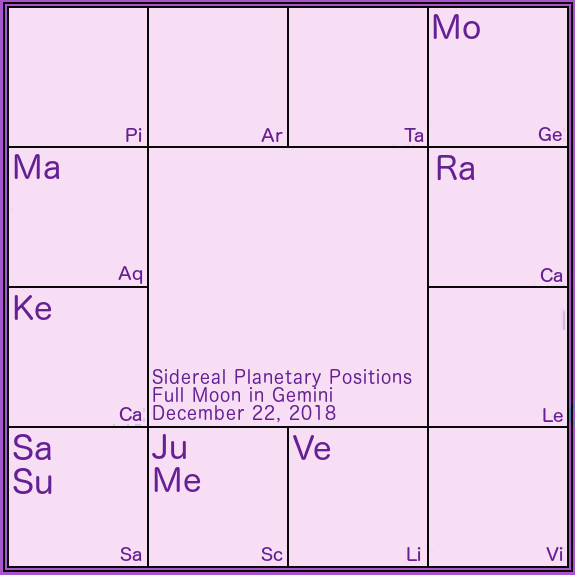
Full Moon in Gemini
The full Moon will reach maximum illumination at 6° sidereal Gemini, opposite the Sun at 6° sidereal Sagittarius. Also in Ardra nakshatra, this Full Moon is aligned with the outer reaches of our galaxy, stretching towards far distant space. This energy is appropriate for the winter solstice, which is a deeply yin time of year as we become more still in the lengthy hours of darkness, allowing more space in our beings, and in between our bouts of activity.
Ardra
Ardra, also Arudra, is a turbulent place, however, ruled by Lord Shiva in the form of Rudra, the fierce bringer of storms. Though there is a certain energy of renewal here, it is the type of renewal that comes after difficult or destructive situations. The full Moon here can help us to truly let go of some of the things from the past year that we no longer need, but for some it could be a chaotic-feeling process.
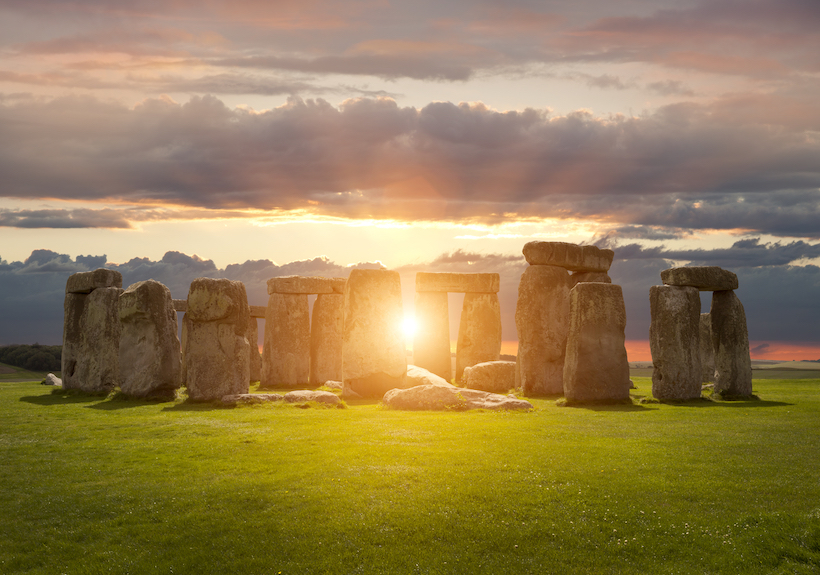 Solstice
Solstice
The winter solstice is when the Sun is farthest from its northern course, allowing the night hours to exceed the day, the further you go north. It is also a turning point in the cycle of light, and after this point in time the light will slowly begin to return and the days lengthen. The solstice and the days surrounding are like a still point, however, like the powerful moment between exhalation and inhalation. Consider incorporating an awareness of this moment in the breath cycle into your meditation practice during this time of year.
It is somewhat paradoxical that we will experience the solstice and the full Moon together, as the winter solstice is a time to be very inward, and full Moon energy usually draws us out into a more extroverted state. Gemini is a dual sign that helps us to look at both sides of life, however, so it is also appropriate. With all things, there is a lesson coming forth to teach us about balance, and how to balance these energies, nourishing our inward nature while likely participating in some kind of gatherings or celebrations that draw our energy outward.
From the 22nd through the end of the year will be a waning phase for the Moon, and during this lunar cycle in particular, it is a potent time to allow yourself to let go of all the baggage from the past year, allowing it to compost and creating fertile ground for the next year to come (just as Shiva, the cosmic composter, brings this energy through the stormy rains).
Though the holidays are a time to celebrate, it’s important to be careful right now of overexerting your yang or active energy, and to recognize the real gift of cultivating yin during these dark months. It is a time to create more inward space for your body, mind and spirit. The dormant season of winter is a time to nourish and rejuvenate, and it’s important not to let these celebrations become depleting.
Jupiter-Mercury War
Jupiter and Mercury will be engaged in a planetary war (graha yuddha) from midday on December 20th through early morning on the 22nd. During this time the two planets will be traveling within one degree of each other, in sidereal Scorpio. This can bring up an internal conflict between what we strongly believe (philosophically, spiritually, or politically), and what makes sense in a practical, earthly way. This war can also create a paradox between two or more areas of your life, those ruled by Jupiter and Mercury in your individual natal chart. Check out your chart and pay attention to the interaction of what these planets rule for you over the next few days.
Venus
Venus is nearing the end of his four-month transit through sidereal Libra. Strong and powerful in his own sign, the ideals of beauty, pleasure and harmony have been forefront for many of us over the last few months. This transit began on August 31st, and Venus then appeared to slow to a halt and then travel in retrograde motion through Libra from October 5th through November 15th. This retrograde stint gave us a chance to really closely examine our relationships, as well as our approaches to happiness in general.
As we move forward through these last weeks of Venus in Libra, we should be integrating some of the lessons we have learned through this transit. What have the past few months taught you, and how can you proceed with more wholeness? What are your methods for seeking pleasure, and are these working for you? If not, what needs to change? When you get what you think you want, are you truly happy?
 Venus is the planet that reminds us that we aren’t usually truly happy if our pleasure comes at the expense of someone else’s whom we care about. How are you at compromising in your relationship? Is it too little, or too much, costing one of you (and thus both) the happiness you deserve? What kind of boundaries do you have with others in general, and are those working for you (or them)?
Venus is the planet that reminds us that we aren’t usually truly happy if our pleasure comes at the expense of someone else’s whom we care about. How are you at compromising in your relationship? Is it too little, or too much, costing one of you (and thus both) the happiness you deserve? What kind of boundaries do you have with others in general, and are those working for you (or them)?
This transit may also have gotten you in touch with the way you handle sensual indulgences, be it food, drink, shopping, sex, or intoxicants. The drive may have been turned on high during this period, with a chance to slow down and scrutinize your methods during the weeks of Venus Retrograde. Moving into the new year, as Venus transits into sidereal Scorpio on January 1st, take the opportunity to harvest and integrate the lessons you have learned about yourself, and your own Venusian nature.
2019
As we come into the New Year I will be adding more updates on what to expect, as well as co-hosting a Webinar on 2019 Transits with a number of my Jyotish colleagues. Be sure to tune into the webinar, stay on the free mailing list, and consider getting an individual reading to see how the coming year’s transits will affect you personally.
Many blessings and Happy Solstice!

by Somya Devi | Nov 21, 2018 | Astrology, Conjunctions, Retrograde
Full Moon in Taurus
The Moon is waxing towards its brightest point, to align fully opposite the Sun for a full Moon in Taurus at 9:39 pm PST on Thanksgiving night, Thursday, November 22nd. The Moon will be in its sign of exaltation in early sidereal Taurus, in the Vedic nakshatra of Krittika, opposite the Sun in Scorpio. Mars, Jupiter and a retrograde Mercury all aspect this full Moon, while Venus rules over it in Taurus. With the Moon and the mind happy and grounded in this fertile earth sign, this is truly a fitting time to let the heart settle and give thanks for what is.
Exaltation in Taurus
We began this lunar cycle with the Moon dark and approaching debilitation, on November 7th. The Moon is fully “debilitated” in the third degree of Scorpio (although Sun & Moon conjoined to begin this cycle near the end of Libra). In the passionate water sign of Scorpio, the mind becomes aware of its most sensitive points, and can go through turbulent emotions as it rides the waves under Mars’ rulership.
Moon is considered “exalted” in the opposite sign of Taurus, where we find this week’s full Moon. Taurus is an earth sign ruled by Venus. The earth element helps our minds and hearts to find more stability and become grounded, and our emotions are less likely to be tossed about by external forces. Taurus is ruled by Venus, the planet that ultimately helps us to find ways to be happy, so there is a natural inclination towards seeing the beauty and harmony of life when the Moon is here.
Venus is still transiting his own sign of Libra, and getting gradually stronger as he picks up speed after six weeks in retrograde motion. (Though feminine in nature, Venus, like all planets in Jyotish, gains a masculine pronoun when personified.) Venus helps the mind to be happy when the Moon is under his rule, because Venus drives us towards pleasure and happiness, and helps us to look for and see beauty. This is a great outlook for approaching the Thanksgiving holiday, especially when difficult family dynamics may be present. On this holiday where there is a tendency to overindulge in consumable pleasures, however, be especially mindful this year, as Venus (and Jupiter) could help to push that to extremes.
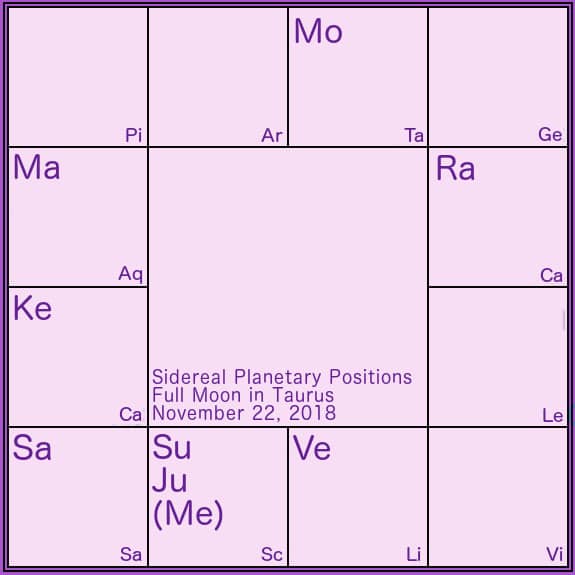
Krittika Nakshatra
Within the Vedic system, Krittika nakshatra spans from 26°40′ Aries to 10° Taurus. This star-sign is known as “the cutter” and is represented by an axe, a razor blade, or a flame. Agni, the Lord of Fire, rules here, and his sharp and transforming nature drive the energy of this nakshatra. Though we are experiencing the beauty-seeking nature of Venus, we are also receiving the purifying and sattvic influence of the Sun, who rules this nakshatra, while the Moon transits here.
This nakshatra can be located in the sky as the cluster of seven stars also known as the Pleiades. In Vedic mythology, these correlate with the wives of the seven sages who found and nursed the baby Kartikeya, the son that Shiva and Parvati birthed through the vehicle of the river Ganga. There is a maternal and nurturing quality to this star, in addition to its power to help us to cut through the unnecessary in our processes of purification. Fittingly, the Indian saint “Amma” (Amritanandamayi) was born under Krittika nakshatra, and demonstrates these qualities of being a nurturing mother to all as well as a powerful sattvic purifier.
Aspects: Mars, Jupiter & Retrograde Mercury
In addition to full illumination from the Sun, this full Moon is also receiving light and energy from Mars, Jupiter, and Mercury (though Jupiter is quite combust, within three degrees of the Sun). Mars’ influence can stimulate the mind into a more rajasic state, and can add a bit of heat and tension. With Mercury also in retrograde motion, be very aware around getting into arguments or trying to explain (or re-explain) your point of view to others. Though Jupiter sends some benefic and inspiring influence, the loftiness of your ideas may be burned up and lost as you attempt to communicate from a philosophical or idealistic place. Mercury will continue in retrograde motion through the next New Moon, on December 6th.

by Somya Devi | Nov 5, 2018 | Astrology, Conjunctions, Holy Days, Planets Changing Signs, Retrograde, Uncategorized
The Moon is waning towards total darkness as he approaches the Sun in late sidereal Libra. The dark Moon night of November 6th will precede the “new Moon” moment at 9:02 am PST on Wednesday, November 7th, when Sun and Moon align exactly in late Libra, in Vishakha nakshatra. This will begin a lunar cycle in the mood of Libra, and also bring in Diwali, the Hindu festival of lights. With Venus already powerful in the sky right now, this lunar cycle will cause us to focus even deeper on relationships, harmony, and happiness in our lives, and examine closely how we seek to fulfill our desires and find love on the human plane.
Libra
Libra is called Tula in Sanskrit meaning “scale” and is depicted as such in both eastern and western astrology. The natural seventh sign, opposite Aries, Libra is where we recognize our reflections, seeing the other who is opposite to us, and learning how to travel through life balancing our individual instincts with our need to create harmonize with those around us, often people with opposite will or nature.
Venus is the ruler of Libra, and Venus governs the human nature within us that seeks pleasure and happiness. While Mars gives us an instinct to assert ourselves strongly and survive, Venus brings in awareness of our pleasure centers and what is sensually pleasing in our field or bodies. A large part of the happiness we seek comes in the form of other people, coinciding with Libra’s “seventh sign” placement.
The problem with other people, however, is that they don’t always want exactly what we want. If it is a loved one, family member, or someone with whom we need to deal on a regular basis, we begin to notice that if we meet our individual desires completely at the expense of their happiness, we won’t actually be happy in the end. We need to learn how to compromise some so that both parties will be happy enough with a situation (and this is easier said than done). The flip-side is when we over-compromise, putting another’s desires entirely before our own, and ending up just as miserable as if we had completely ignored theirs.
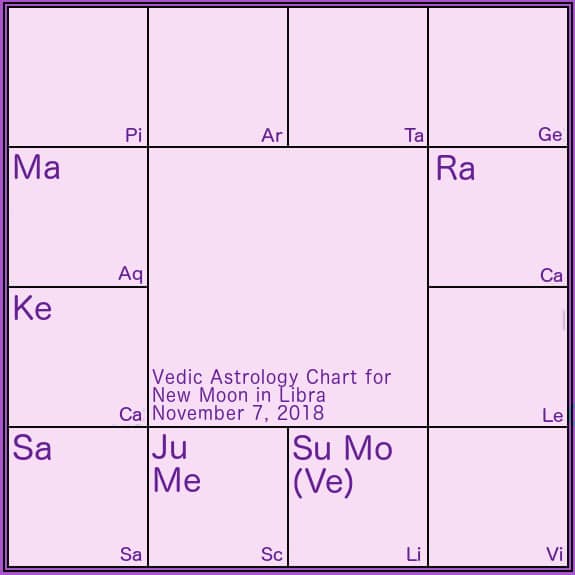
Venus
During this Libra cycle, Libra’s lord, Venus, is joining the Sun and Moon from the onset. He is strong as he travels through his own sign (sva), and even stronger due to his retrograde position (albeit only visible for a short time in the morning currently, since he is traveling so closely to the Sun). This position will give us extra support as we try to navigate the waters of compromise, and insight to be able to reflect back on what we are doing to try to attain happiness. It will help us to see what isn’t working, and gives us the opportunity to try to forge a new path moving forward.
It’s important to look at our own part in conflict and disharmony, and adopt a new attitude or method towards finding happiness and harmony. Venus comes to a halt and turns direct on the 15th, so be sure to take notice of all the insights being offered now and make your plan for how you will move forward.
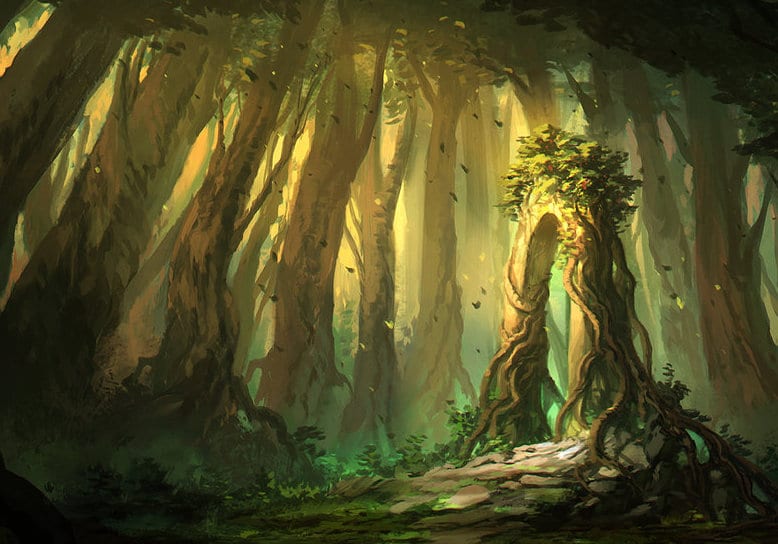 Vishakha
Vishakha
The Sun and Moon are coming together at 21° sidereal Libra for this New Moon, which aligns with the Vedic star-sign known as Vishakha, “the forked branches.” This star is sometimes represented by a set of forked branches, but often as a triumphal archway, indicating that success is possible after doing the difficult work of deciding between two paths. This is even often interpreted as a marriage archway. This star is ruled by the deities Indra and Agni, the chief of the gods and the fire deity, respectively, and can give us quite a bit of power and determination. Under Jupiter’s influence, this nakshatra can be helpful in learning to overcome conflicts and refining our method of compromise and success. Be aware, however, there can be some self-righteousness here due to Jupiter’s and Indra’s influences.
Sun
The Sun is considered neecha or naturally debilitated as he travels through Libra. Since the Sun relates to our sense of strength and vitality, and Libra is the sign of compromising (or over-compromising) with others, it is natural that our individual power can sometimes feel lessened while we elevate the level of energy and attention we give to those around us. Caring for others doesn’t necessarily translate to depleted health, but it can when we overemphasize the outer world and others to the point of neglecting our own self-care. This is a very important time of year to nourish ourselves, and our inner light, as the outer light is descending. Venus’ coincidence in Libra can help us to navigate this balancing act.
Diwali
Hindu culture recognizes this descending light outside, and it is on this New Moon (in the Hindu month of Ashwin) that we celebrate Diwali, the festival of lights. It is a time to invite more light into our lives, our hearts, and our world. This festival celebrates the symbolic victory of light over darkness. At this time we commemorate Lord Ram’s and Sita’s return from exile after fourteen years (story from the Ramayana). Lord Ram embodies the highest qualities of dharma, devotion, compassion, courage, and leadership. It is also a powerful time to connect to the Goddess Lakshmi, calling in her blessings for both material and spiritual prosperity.
Diwali (also seen as Divali, Deepawali or Deepavali) comes from the Sanskrit words deepa (light) and avali (row). It is traditional to light candles throughout Diwali, inviting the highest light into our homes and hearts. The candles are lit to remind us of the inner divine light in us all. Though one flame can be used to light many others, it is not diminished by sharing its power of illumination. We can pray for the peace and happiness of all beings, and each one’s awareness of their inner light.
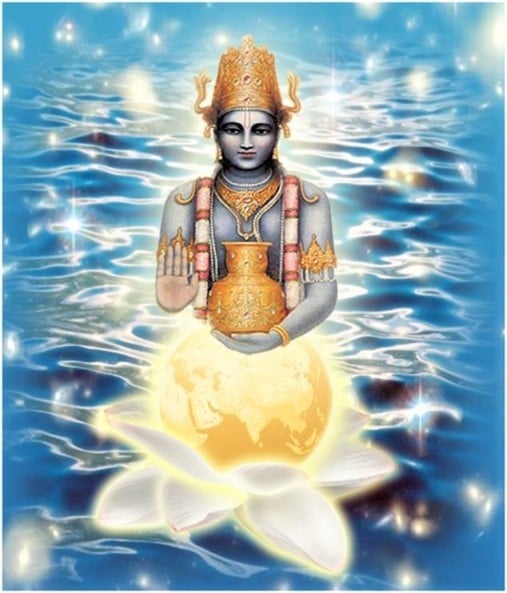 Dhanteras
Dhanteras
Monday, November 5th precedes Diwali with the holiday known as Dhanteras or Dhanvantari Tryodashi (commemorating the birth of Lord Dhanvantari). It is the thirteenth day of the waning Moon in the Vedic month of Ashwin. Lord Dhanvantari is known as the “father of Ayurveda” and the “physician of the Gods.” (Ayurveda is the system of natural medicine from India that is a sister science to yoga and Jyotish.) If you practice any healing tradition, especially Ayurveda, this is a good day to give thanks and call in auspicious blessings to your healing path or practice.
This day also marks Dhanteras, the first day of the Diwali festival. It commemorates the day that Lakshmi emerged from the milk ocean in Vedic lore. In India, it is customary to purchase metals on this day — anything from jewelry to new statues to kitchenware (excluding iron), especially silver and gold — as a part of celebrating Lakshmi and calling in more prosperity. The metals can then be offered to your altar and will absorb and amplify the benefits of worship performed over the few days of Diwali.
Mars-Ketu Separation
After six long months of conjunction in sidereal Capricorn, Mars and Ketu are finally separating. On November 5th Mars leaves Capricorn and crosses over into Aquarius. This has been a complicated transit, as Mars journeyed through his sign of exaltation, strengthening our courage and will, but was simultaneously plagued by Ketu’s fear and confusion.
With a retrograde stint topped with a set of three eclipses in the summer, we had a lot of time to try to understand our deepest fears and how they influence our courage and will (especially in areas of your life ruled by Mars or aligned with Capricorn). Moving forward, we will feel some of the pressure lift from these areas, and hopefully we were able to glean a lot of learning from the visible shadows presented throughout this transit.
Personal readings are available here to help you to better understand your relationship with each planet and how the current transits may affect you.
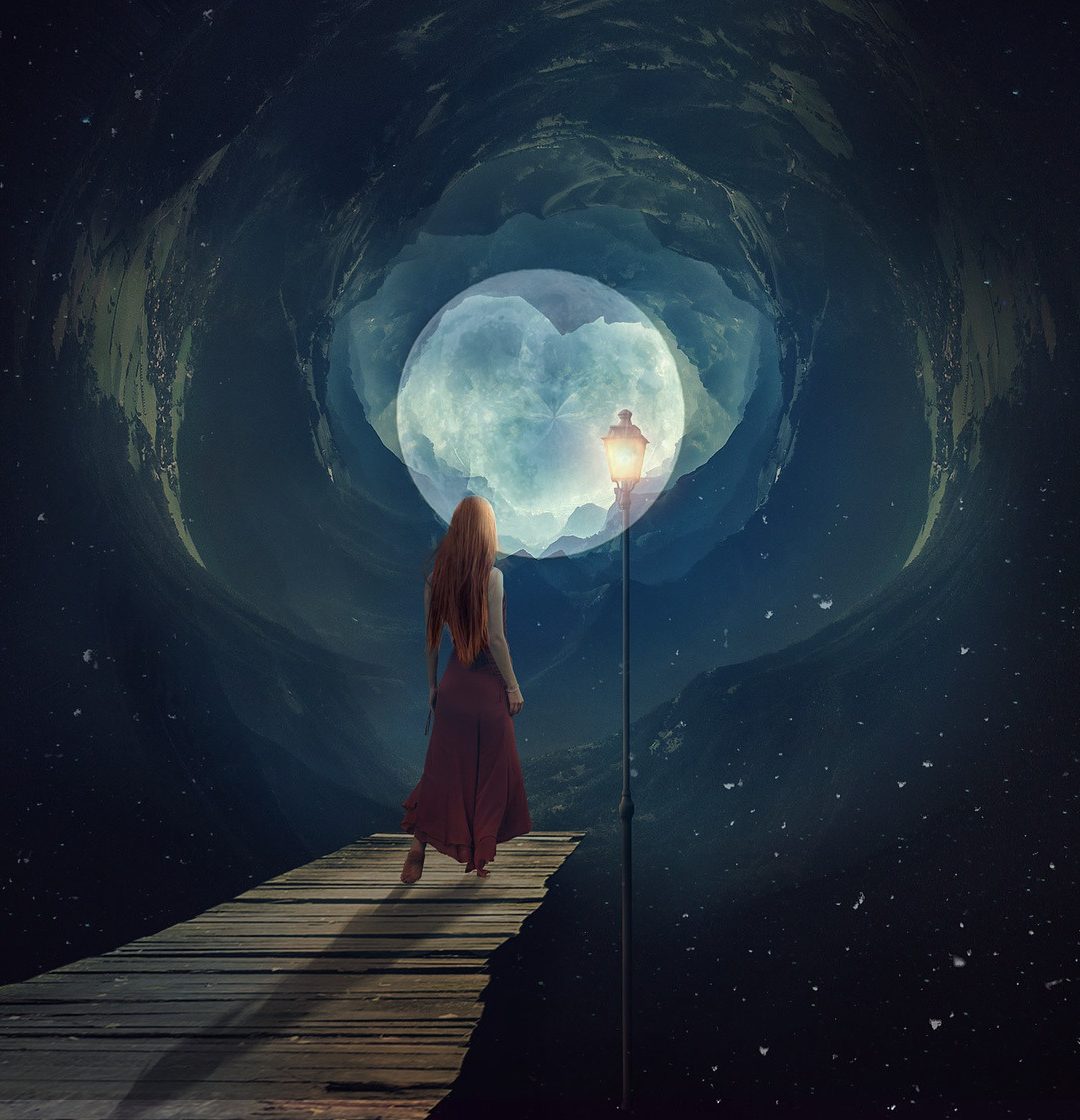
by Somya Devi | Oct 23, 2018 | Astrology, Conjunctions, Planets Changing Signs, Retrograde
The full Moon will come directly opposite the Sun at 9:45 am PDT tomorrow, October 24th. With the Sun at 7° sidereal Libra and in Swati nakshatra, the Moon waxes to fullness at 7° sidereal Aries, in Ashwini nakshatra. The energy of this full Moon will help us to focus our energy, and may inspire us to get our bodies moving, shedding some layers from the past season.

Aries-Libra opposition
With the Sun currently transiting sidereal Libra (October 17th- November 16th), he is in his sign of debilitation. The Sun is literally the source of our power here on earth, and relates to our physical strength and vitality as well as our spiritual strength and awareness of connection to source. When he is in Libra he is weakened, as Libra is ruled by Venus, turning our attention towards pleasures and indulgences, which can take a toll on our health and reduce the Sun’s ability to help us to purify ourselves. Likewise, the Sun in Libra also causes us to relate our personal strength with that of our partners and other people, since Libra signifies relationships. We may find ourselves drained of energy this month as we try to take care of others around us, neglecting personal power and self-care.
As the Sun shines his light into Aries, his sign of exaltation, he illuminates the full Moon here and we are offered the chance to elevate and capture more of the Sun’s energy. Around the time of this full Moon we may take notice of our own bodies, and the possible depletion we have encountered during the Sun’s trip through Libra. This is a time to harness his strength and create more balance between self-care and care of those around us. Coinciding with the change of seasons, this is a great time to put some energy into a cleanse or a new physical or spiritual workout routine.
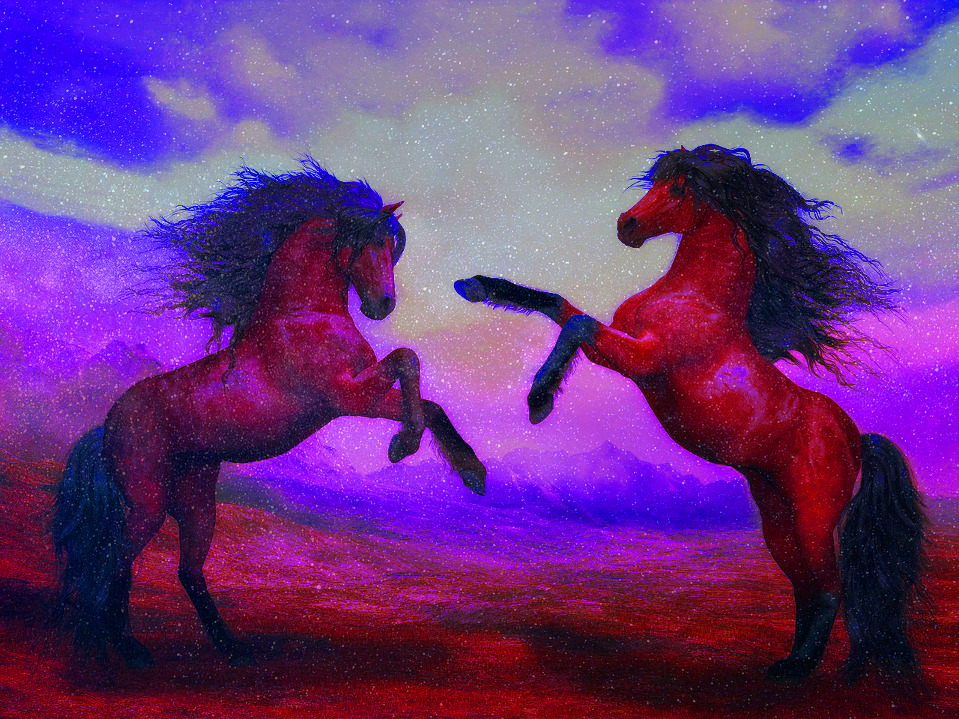 Ashwini
Ashwini
The full Moon also aligns with Ashwini nakshatra, the first of the 27 Vedic star-signs. This asterism always offers the energy for a fresh start, so with the full Moon here it also supports shedding some energy from the past season and setting our focus in a new direction. Ruled by the Ashwin Kumaras, the horse-headed physicians of the gods, in Vedic lore, there is a potent healing energy here. Working with medicines or healing ceremonies around this full Moon can be especially potent.
Venus
In Libra, the Sun’s energy is under Venus’s rulership. As Venus also currently transits Libra, this may help to increase the general sense of strength and Sun energy available, but with Venus increasingly combust every day, both continue to be challenged. This full Moon certainly highlights for us whether we are giving too much energy to our relationships or others, and neglecting our own strength and health simultaneously, or vice versa.
Venus is also in retrograde motion at the moment, since October 5th and through November 15th, which is causing us to slow down and take a closer look at our relationships, and relating styles. People or patterns from the past may be resurfacing, and it is important to examine how we approach compromise and conflict, taking the opportunity to forge new patterns by the time Venus goes direct again. Venus enters retrograde motion about every 18 months, so it will not occur again until 2020.
Jupiter in Scorpio
Jupiter is settling into his position in sidereal Scorpio, illuminating this mystic and transformational part of the sky for the next year. Whatever houses he rules and transits in your chart may receive some particular affects this year, as you dive into your fears and feelings, waging the inner war to come out stronger than you were before in specific areas of your life. In general, this year can be a good time to study the mystic arts, such as astrology, yoga, tantra, or tarot.
Personal natal chart readings are available here.

by Somya Devi | Oct 4, 2018 | Astrology, Conjunctions, Planets Changing Signs, Retrograde
I love this time of year. Having passed the equinox on September 22nd, the dark of night comes noticeably earlier. The air temperature, moisture and barometric pressure have taken a definite turn. And the instinct to nest and cozy up at home is on.
From now through the spring equinox, we in the northern hemisphere are in the yin portion of the year, where nighttime exceeds day, and our energy is more naturally directed inward. With fewer hours to be out in the world acting, there is more time to spend still and being. This is a time for the mystic feminine to thrive.
Monday, October 8th will bring a dark Moon night to start the first lunar cycle fully in the yin season. At 8:47 pm PDT, the Sun and Moon align at 21° sidereal Virgo, in Hasta nakshatra. This is a great way to start a season of grounding into ourselves, nurturing our feminine essence and our creative potential. Fittingly, this cycle brings with it the Navaratri festival, the nine nights of celebrating the goddess in her many forms.

Virgo Cycle
Virgo is the feminine earth sign ruled by Mercury. In Sanskrit, Virgo is Kanya, literally the “girl” or the “maiden.” This sign relates to fertility, as well as a pure feminine being. Virgo’s nature compels us to try to take care of everyone and all the details, and as the Sun moves into Libra, his sign of debilitation, later this month, we must be careful not to overexert ourselves and become depleted.
With exalted Mars and Ketu still transiting the fifth from Virgo, this month will call us to explore our creative potential, and what fears and resistance we may hold around that. With Saturn transiting the fourth and Mercury, Jupiter and Venus in the second, there is a lot of energy going towards the home and family this month.
Hasta
Within Virgo, the Sun and Moon align in Hasta nakshatra to begin this lunar cycle. Hasta is “the hand,” and implies all things crafty. We find potential to take up any number of manual skills or projects this month, as well as utilizing the intellect (Mercury) to craft our situations towards our goals. Ruled by the Moon, this star brings forth our feminine nature and guides us from the heart, so be sure to listen in the stillness of the dark Moon nights.
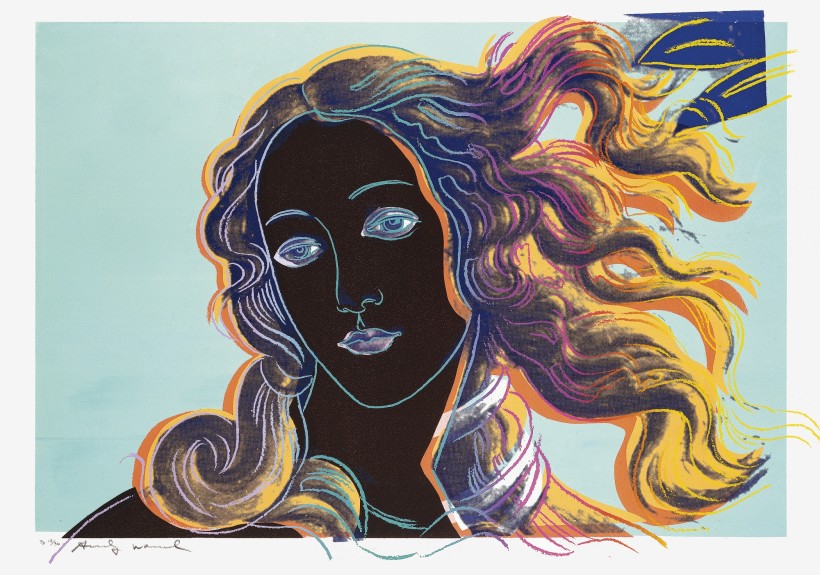
I just love this Warhol image for Retrograde Venus!
Venus
Venus has come to a stop and is entering retrograde motion on October 5th. For all of us, this will be an opportunity to slow down and retrace the steps we have taken towards happiness, as well as look closely at our relationships and our styles of relating. It may feel like a slow-down our happiness or relationships are challenged right now, but every challenge is an opportunity for our own self-development. It’s a good time to work on developing new skills in relating, whether by a communication class, couples’ workshop, or any personal development coaching work.
You may also experience things slowing down in the areas of your life ruled by Venus in your natal chart, different for each Vedic rising sign.
Jupiter
For a few more days, Jupiter and Venus are joined in sidereal Libra, but Jupiter will complete his transit here and move into sidereal Scorpio on October 11th. This next Jupiter transit will last through November 4, 2019. Jupiter in Scorpio can expand our opportunity to connect with the mystic. The depth of self-inquiry and self-development practices will grow during this period. Passions can be heightened and intensified, and our philosophical warrior will be strong.
 Navaratri
Navaratri
The nine nights of the goddess is a festival celebrated by Hindus worldwide. Navaratri will begin on the first night of the waxing Moon this lunar cycle, starting October 9th. On each of nine consecutive nights (nav + ratri), we can worship the goddess, Devi, through her many forms. Most notably this festival celebrates the goddess Durga in nine of her forms, but in other parts of India the festival commemorates Durga/Kali, Lakshmi, and Sarasvati for three nights each.
Devi is the creatrix, the warrioress, the nurturer, the purifyer, the protector. She can be found in the innocent and fertile maiden as well as the wise and learned crone. She is both the nurturing mother, and the one who gives “tough love.” The impassioned lover, the devoted bhakta, the disciplined yogini. We see Devi appear through us in innumerable manifestations. Through her many forms, she teaches us and offers us countless blessings–love, compassion, courage, learning, discipline, surrender, success, enlightenment, and bliss.
This festival is a time for honoring and celebrating the supreme feminine power in all her glory, and the many blessings she bestows upon us. Stay tuned for daily updates on how to connect with the many forms of the Goddess.

 Nodes Are Changing Signs!
Nodes Are Changing Signs! The nodes, astronomically are the places where the Sun’s and Moon’s paths intersect. The ecliptic is the apparent paths that the Sun travels “around” the Earth. The Moon’s orbits is not completely flat or parallel with the Sun’s, but slightly inclined, so that it passes this line and is sometimes to the north of it, sometimes to the south. We can measure astronomically and by observation when these crossings happen. To get the mean node, we take an average distance between these two points based on how many days it takes the Moon to get from one to the other. The true node is calculated using a method that also accounts for the slight wobble of the earth and the Moon’s orbit around it.
The nodes, astronomically are the places where the Sun’s and Moon’s paths intersect. The ecliptic is the apparent paths that the Sun travels “around” the Earth. The Moon’s orbits is not completely flat or parallel with the Sun’s, but slightly inclined, so that it passes this line and is sometimes to the north of it, sometimes to the south. We can measure astronomically and by observation when these crossings happen. To get the mean node, we take an average distance between these two points based on how many days it takes the Moon to get from one to the other. The true node is calculated using a method that also accounts for the slight wobble of the earth and the Moon’s orbit around it.









 Vishakha
Vishakha Dhanteras
Dhanteras





